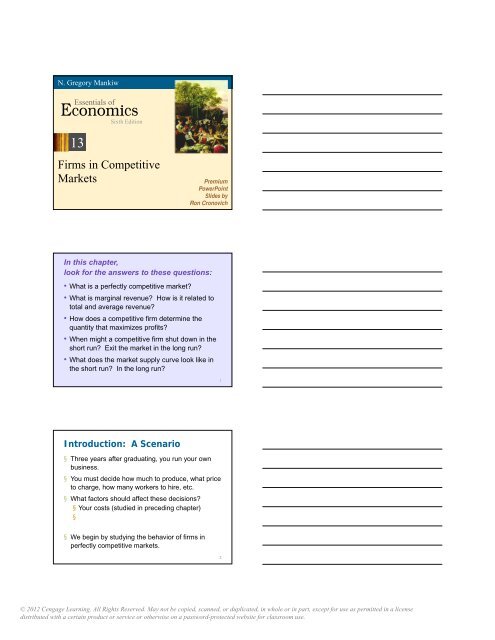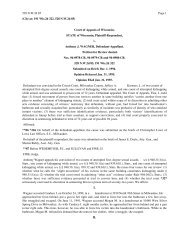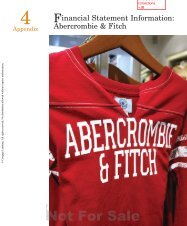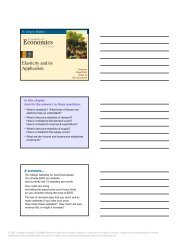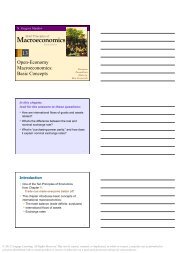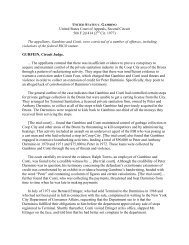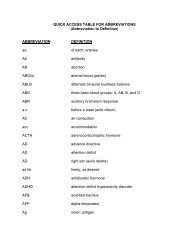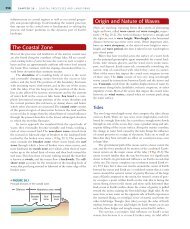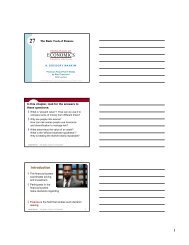Economics - Cengage Learning
Economics - Cengage Learning
Economics - Cengage Learning
Create successful ePaper yourself
Turn your PDF publications into a flip-book with our unique Google optimized e-Paper software.
N. Gregory Mankiw<br />
Essentials of<br />
<strong>Economics</strong><br />
Sixth Edition<br />
13<br />
Firms in Competitive<br />
Markets Premium<br />
PowerPoint<br />
Slides by<br />
Ron Cronovich<br />
In this chapter,<br />
look for the answers to these questions:<br />
• What is a perfectly competitive market?<br />
• What is marginal revenue? How is it related to<br />
total and average revenue?<br />
• How does a competitive firm determine the<br />
quantity that maximizes profits?<br />
• When might a competitive firm shut down in the<br />
short run? Exit the market in the long run?<br />
• What does the market supply curve look like in<br />
the short run? In the long run?<br />
Introduction: A Scenario<br />
§ Three years after graduating, you run your own<br />
business.<br />
§ You must decide how much to produce, what price<br />
to charge, how many workers to hire, etc.<br />
§ What factors should affect these decisions?<br />
§ Your costs (studied in preceding chapter)<br />
§<br />
§ We begin by studying the behavior of firms in<br />
perfectly competitive markets.<br />
© 2012 <strong>Cengage</strong><strong>Learning</strong>. All Rights Reserved. May not be copied, scanned, or duplicated, in whole or in part, except for use as permitted in alicense<br />
distributed with a certain product or service or otherwise on a password-protected website for classroom use.<br />
1<br />
2
Characteristics of Perfect Competition<br />
1.<br />
2.<br />
3.<br />
§ Because of 1 & 2, each buyer and seller is a<br />
The Revenue of a Competitive Firm<br />
§ Total revenue (TR)<br />
§ Average revenue (AR)<br />
§ Marginal revenue (MR):<br />
ACTIVE LEARNING 1<br />
Calculating TR, AR, MR<br />
Fill in the empty spaces of the table.<br />
Q P TR AR MR<br />
0<br />
1<br />
2<br />
3<br />
4<br />
5<br />
$10<br />
$10<br />
$10<br />
$10<br />
$10<br />
$10<br />
$40<br />
$50<br />
n/a<br />
$10<br />
$10<br />
© 2012 <strong>Cengage</strong><strong>Learning</strong>. All Rights Reserved. May not be copied, scanned, or duplicated, in whole or in part, except for use as permitted in alicense<br />
distributed with a certain product or service or otherwise on a password-protected website for classroom use.<br />
3<br />
4
MR = P for a Competitive Firm<br />
§ A competitive firm can keep increasing its output<br />
without affecting the market price.<br />
§ So, each one-unit increase in Q causes revenue<br />
to rise by<br />
Profit Maximization<br />
§ What Q maximizes the firm’s profit?<br />
§ To find the answer, “think at the margin.”<br />
If increase Q by one unit,<br />
§ If MR > MC, then<br />
§ If MR < MC, then<br />
Profit Maximization<br />
At any Q with<br />
MR > MC,<br />
increasing Q<br />
raises profit.<br />
At any Q with<br />
MR < MC,<br />
reducing Q<br />
raises profit.<br />
(continued from earlier exercise)<br />
Q<br />
0<br />
1<br />
2<br />
3<br />
4<br />
5<br />
TR<br />
$0<br />
10<br />
20<br />
30<br />
40<br />
50<br />
TC<br />
$5<br />
9<br />
15<br />
23<br />
33<br />
45<br />
Profit<br />
–$5<br />
1<br />
5<br />
7<br />
7<br />
5<br />
MR<br />
$10<br />
10<br />
10<br />
10<br />
10<br />
MC<br />
$4<br />
6<br />
8<br />
10<br />
12<br />
© 2012 <strong>Cengage</strong><strong>Learning</strong>. All Rights Reserved. May not be copied, scanned, or duplicated, in whole or in part, except for use as permitted in alicense<br />
distributed with a certain product or service or otherwise on a password-protected website for classroom use.<br />
7<br />
8<br />
DProfit =<br />
MR – MC<br />
$6<br />
4<br />
2<br />
0<br />
–2<br />
9
MC and the Firm’s Supply Decision<br />
At Q a,<br />
At Q b,<br />
At Q 1,<br />
Costs<br />
P 1<br />
MC<br />
MC and the Firm’s Supply Decision<br />
If price rises to P 2,<br />
then the profitmaximizing<br />
quantity<br />
The MC curve<br />
determines the<br />
firm’s Q at any price.<br />
Hence,<br />
Costs<br />
P 1<br />
Shutdown vs. Exit<br />
§ Shutdown:<br />
§ Exit:<br />
§ A key difference:<br />
Q 1<br />
MC<br />
MR<br />
Q<br />
MR<br />
Q<br />
10<br />
11<br />
12<br />
© 2012 <strong>Cengage</strong><strong>Learning</strong>. All Rights Reserved. May not be copied, scanned, or duplicated, in whole or in part, except for use as permitted in alicense<br />
distributed with a certain product or service or otherwise on a password-protected website for classroom use.
A Firm’s Short-run Decision to Shut Down<br />
§ Cost of shutting down:<br />
§ Benefit of shutting down:<br />
§ So, shut down if<br />
§ Divide both sides by Q:<br />
§ So, firm’s decision rule is:<br />
A Competitive Firm’s SR Supply Curve<br />
If P > AVC, then<br />
firm produces Q<br />
where P = MC.<br />
If P < AVC, then<br />
firm shuts down<br />
(produces Q = 0).<br />
Costs<br />
The Irrelevance of Sunk Costs<br />
§ Sunk cost:<br />
MC<br />
ATC<br />
AVC<br />
§ Sunk costs should be irrelevant to decisions;<br />
you must pay them regardless of your choice.<br />
§ FC is a sunk cost: The firm must pay its fixed<br />
costs whether it produces or shuts down.<br />
§ So,<br />
Q<br />
13<br />
14<br />
15<br />
© 2012 <strong>Cengage</strong><strong>Learning</strong>. All Rights Reserved. May not be copied, scanned, or duplicated, in whole or in part, except for use as permitted in alicense<br />
distributed with a certain product or service or otherwise on a password-protected website for classroom use.
A Firm’s Long-Run Decision to Exit<br />
§ Cost of exiting the market:<br />
§ Benefit of exiting the market:<br />
§ So, firm exits if<br />
§ Divide both sides by Q to write the firm’s<br />
decision rule as:<br />
A New Firm’s Decision to Enter Market<br />
§ In the long run, a new firm will enter the market if<br />
it is profitable to do so:<br />
§ Divide both sides by Q to express the firm’s<br />
entry decision as:<br />
The Competitive Firm’s Supply Curve<br />
The firm’s<br />
LR supply curve<br />
is<br />
Costs<br />
MC<br />
Q<br />
16<br />
17<br />
LRATC<br />
18<br />
© 2012 <strong>Cengage</strong><strong>Learning</strong>. All Rights Reserved. May not be copied, scanned, or duplicated, in whole or in part, except for use as permitted in alicense<br />
distributed with a certain product or service or otherwise on a password-protected website for classroom use.
ACTIVE LEARNING 2<br />
Identifying a firm’s profit<br />
Determine<br />
this firm’s<br />
total profit.<br />
Identify the<br />
area on the<br />
graph that<br />
represents<br />
the firm’s<br />
profit.<br />
Costs, P<br />
MC<br />
P = $10 MR<br />
ATC<br />
$6<br />
ACTIVE LEARNING 3<br />
Identifying a firm’s loss<br />
Determine<br />
this firm’s<br />
total loss,<br />
assuming<br />
AVC < $3.<br />
Identify the<br />
area on the<br />
graph that<br />
represents<br />
the firm’s<br />
loss.<br />
Costs, P<br />
$5<br />
A competitive firm<br />
50<br />
A competitive firm<br />
MC<br />
Q<br />
ATC<br />
P = $3 MR<br />
30<br />
Market Supply: Assumptions<br />
1) All existing firms and potential entrants<br />
2) Each firm’s costs<br />
3) The number of firms in the market is<br />
§ ______________ in the short run<br />
due to<br />
§ ______________ in the long run<br />
due to<br />
Q<br />
23<br />
© 2012 <strong>Cengage</strong><strong>Learning</strong>. All Rights Reserved. May not be copied, scanned, or duplicated, in whole or in part, except for use as permitted in alicense<br />
distributed with a certain product or service or otherwise on a password-protected website for classroom use.
The SR Market Supply Curve<br />
§ As long as P ≥ AVC, each firm will produce its<br />
profit-maximizing quantity<br />
§ Recall from Chapter 4:<br />
At each price, the market quantity supplied is<br />
the sum of quantities supplied by all firms.<br />
The SR Market Supply Curve<br />
Example: 1000 identical firms<br />
At each P, market Q s = 1000 x (one firm’s Q s )<br />
P 1<br />
P<br />
10<br />
One firm<br />
MC<br />
AVC<br />
Q<br />
(firm)<br />
P 1<br />
P<br />
10,000<br />
Market<br />
Entry & Exit in the Long Run<br />
S<br />
24<br />
Q<br />
(market)<br />
§ In the LR, the number of firms can change due<br />
to entry & exit.<br />
§ If existing firms earn positive economic profit,<br />
§ If existing firms incur losses,<br />
25<br />
26<br />
© 2012 <strong>Cengage</strong><strong>Learning</strong>. All Rights Reserved. May not be copied, scanned, or duplicated, in whole or in part, except for use as permitted in alicense<br />
distributed with a certain product or service or otherwise on a password-protected website for classroom use.
The Zero-Profit Condition<br />
§ Long-run equilibrium:<br />
The process of<br />
§ Zero economic profit occurs when<br />
§ Since firms produce where<br />
the zero-profit condition is<br />
§ Recall that MC intersects ATC at minimum ATC.<br />
§ Hence, in the long run,<br />
Why Do Firms Stay in Business<br />
if Profit = 0?<br />
§ Recall, economic profit is revenue minus all costs,<br />
including<br />
§ In the zero-profit equilibrium,<br />
The LR Market Supply Curve<br />
In the long run,<br />
the typical firm<br />
earns zero profit.<br />
P =<br />
min.<br />
ATC<br />
P<br />
One firm<br />
MC<br />
LRATC<br />
Q<br />
(firm)<br />
P<br />
Market<br />
27<br />
28<br />
Q<br />
(market)<br />
29<br />
© 2012 <strong>Cengage</strong><strong>Learning</strong>. All Rights Reserved. May not be copied, scanned, or duplicated, in whole or in part, except for use as permitted in alicense<br />
distributed with a certain product or service or otherwise on a password-protected website for classroom use.
SR & LR Effects of an Increase in Demand<br />
P 1<br />
P<br />
One firm<br />
MC<br />
ATC<br />
Q<br />
(firm)<br />
P 1<br />
P<br />
Market<br />
S 1<br />
long-run<br />
supply<br />
D1 Q<br />
(market)<br />
Why the LR Supply Curve Might Slope Upward<br />
§ The LR market supply curve is horizontal if<br />
A<br />
Q 1<br />
1) all firms have identical costs, and<br />
2) costs do not change as other firms enter or<br />
exit the market.<br />
§ If either of these assumptions is not true,<br />
then LR supply curve slopes upward.<br />
1) Firms Have Different Costs<br />
§ As P rises, firms with lower costs enter the market<br />
before those with higher costs.<br />
§ Further increases in<br />
§ Hence, LR market supply curve slopes upward.<br />
§ At any P,<br />
§ For the marginal firm,<br />
§ For lower-cost firms,<br />
30<br />
31<br />
32<br />
© 2012 <strong>Cengage</strong><strong>Learning</strong>. All Rights Reserved. May not be copied, scanned, or duplicated, in whole or in part, except for use as permitted in alicense<br />
distributed with a certain product or service or otherwise on a password-protected website for classroom use.
2) Costs Rise as Firms Enter the Market<br />
§ In some industries,<br />
§ The entry of new firms<br />
§<br />
§ Hence, an increase in P is required to increase<br />
the market quantity supplied, so the supply<br />
curve is upward-sloping.<br />
CONCLUSION:<br />
The Efficiency of a Competitive Market<br />
§ Profit-maximization:<br />
§ Perfect competition:<br />
§ So, in the competitive eq’m:<br />
§ Recall, MC is cost of producing the marginal unit.<br />
P is value to buyers of the marginal unit.<br />
§ So,<br />
§ In the next chapter, monopoly: pricing and<br />
production decisions, deadweight loss, regulation.<br />
33<br />
34<br />
© 2012 <strong>Cengage</strong><strong>Learning</strong>. All Rights Reserved. May not be copied, scanned, or duplicated, in whole or in part, except for use as permitted in alicense<br />
distributed with a certain product or service or otherwise on a password-protected website for classroom use.


